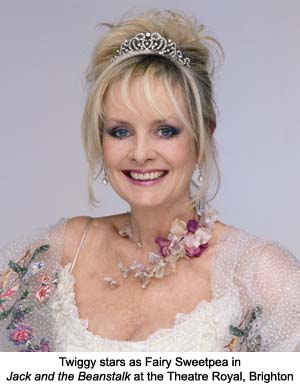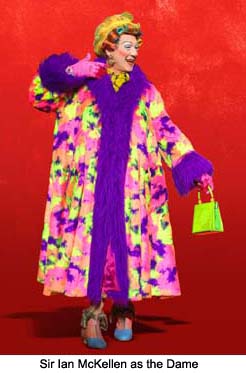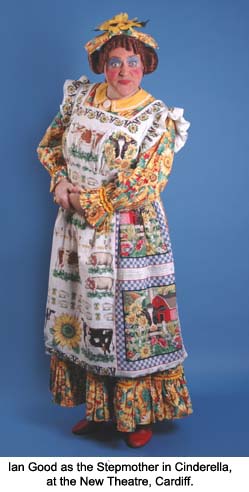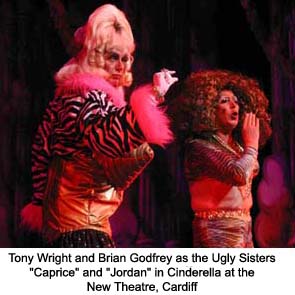The Gender-Bending Holiday Pantomime
by Julia Lynam
 In
the momentary pause as the lights go down the sweet-sucking, ice cream slurping, popcorn crunching crowd falls silent with anticipation.
Suddenly a firecracker explodes and from the billowing smoke an
evil red devil emerges, entering from the left, the sinister side
of the stage. He laughs wickedly, and curses the protagonists
we're about to meet, delighting in the discomfitures that will be
visited on them and gloating over their misfortunes. "Not so
fast" replies a beautiful fairy, entering stage right to rebuff,
in honeyed tones, the curses of the devil and to declare, with a
wave of her sparkling wand and a sugar-sweet smile, that good
will ultimately triumph over evil. In
the momentary pause as the lights go down the sweet-sucking, ice cream slurping, popcorn crunching crowd falls silent with anticipation.
Suddenly a firecracker explodes and from the billowing smoke an
evil red devil emerges, entering from the left, the sinister side
of the stage. He laughs wickedly, and curses the protagonists
we're about to meet, delighting in the discomfitures that will be
visited on them and gloating over their misfortunes. "Not so
fast" replies a beautiful fairy, entering stage right to rebuff,
in honeyed tones, the curses of the devil and to declare, with a
wave of her sparkling wand and a sugar-sweet smile, that good
will ultimately triumph over evil.
The prologue players retire and the curtain rises on a vibrant
village scene, with happy laughing "boys" and "girls" -- actually
fully-grown and rather glamorous adults in pseudo-ethnic costumes
-- dancing in celebration of a forthcoming marriage, a market
day, or just for the joy of living.
Another pantomime season has begun and another generation of
children is being drawn into the fantastic, amazing, hilarious,
naughty, moral world of this supremely British holiday
entertainment.
For thousands of years people of northern climes have celebrated
the winter solstice, that deeply magical time of year when the
sun's retreat is finally halted, the longest night is endured and
the source of light and life begins to return toward us.
Pantomime is a successor to and an amalgam of many ancient
solstice traditions, from those of the Roman Saturnalia and
medieval mummers through the Italian Renaissance harlequinade to
the burlesque of 19th century music hall. It's popular
entertainment at its most traditional, the "Bread and Circuses"
of modern Britain.
The images conjured up by the word "pantomime" differ enormously
depending on which side of the Atlantic you were born. In the
USA it means simply mime, dumb show of the kind made famous by
France's white-faced Marcel Marceau. In the UK, however,
"pantomime" is a glorious, riotous, and far from silent
theatrical extravaganza presented each year during the Christmas
season in hundreds of theaters by hundreds of acting troupes,
professional and amateur, throughout the length and breadth of
the British Isles.
Pantomime traces its origins to traditions like the medieval
Feast of Fools in which the world was turned topsy-turvy with
drinking, revelry and role reversals, and a commoner with a
reputation for knowing how to enjoy himself was chosen as Lord of
Misrule to preside over the festivities. This festival is thought
to have originated with benevolent Roman masters who allowed
their servants to be boss for a while. Pantomime also owes much
to the mummers of ancient and medieval times, masked clowns who
cavorted to entertain the populace at seasonal festivals. The
earliest mummers' plays, as opposed to unscripted clowning, date
from the eighteenth century and seem to have evolved alongside,
perhaps being influenced by, the developing art of the
pantomime.
 Pantomime itself is full of stock characters,
none of which should ever be omitted! In addition to the devil,
fairy queen and village children, pantomime goers expect to meet
a romantic couple in the form of a beautiful maiden, princess or
otherwise, and a "principle boy", the handsome prince or hero who
is traditionally played by a shapely woman in fishnet tights and
close-fitting jerkin. Pantomime itself is full of stock characters,
none of which should ever be omitted! In addition to the devil,
fairy queen and village children, pantomime goers expect to meet
a romantic couple in the form of a beautiful maiden, princess or
otherwise, and a "principle boy", the handsome prince or hero who
is traditionally played by a shapely woman in fishnet tights and
close-fitting jerkin.
S/he's not the only gender-bender in the show: the pantomime
Dame, perhaps the best-loved character of all, is always
played by a man. Last season Sir Ian McKellen (yes, none other
than Gandalf from Peter Jackson's Lord of the Rings)
camped it up so deliciously as Widow Twankey in Aladdin at
London's Old Vic Theater that he's repeating it this year with
what promises to be another show-stealing series of outrageous
glitzy dresses!
Sir Ian, in a 2003 interview for Film Monthly magazine,
said that pantomime "is the first thing that British kids see in
the theatre when they are very, very young. It's full of dance,
song and poetry, has a simple story, audience participation and
cross-dressing . . . which is why the British love the theatre
so much, because they get it all, like a Christmas pudding."
The Dame brings the bawdy, fun-loving and often compassionate
energy of an older woman to the disentanglement of the plot and
her persona perhaps offers a clue to the remotest link of
pantomime to the all-encompassing mother goddess of prehistoric
times.
Pantomimes are always based, sometimes very loosely, on
traditional fairy tales: Aladdin, featuring the
lamp-discovering boy himself (played by a woman of course), the
beautiful princess whose unlikely name seems to be Won Ton, the
wicked uncle and of course Aladdin's mother, Widow Twankey, who
runs a Chinese laundry, has been a perennial favorite for
centuries, although the popularity of other stories waxes and
wanes. Current favorites are Cinderella, Jack and the
Beanstalk and Snow White. Other popular titles are
Sleeping Beauty and Babes in the Wood, which often
includes the legend of Robin Hood for good measure, but twentieth
century stories from outside the classic fairytale canon, such as
Peter Pan and The Wizard of Oz are growing in
popularity.
 One of the earliest pantomimes, Robinson
Crusoe, presented in 1778 at the Theatre Royal, Drury Lane in
London, wove in the characters of the Italian Commedia del'Arte.
Harlequin, Columbine and the clown Pantaloon, who had all been
introduced more than 100 years earlier to the British court and
theatergoers, were blended into the fantastic story of the
shipwrecked mariner and his companion, Man Friday and set the
tone for the development of pantomime's own stock characters.
This production also incidentally included a young actor called
Joseph Grimaldi who was destined to take the art of pantomime to
a higher level. Grimaldi became the most famous of pantomime
clowns, pioneering the art of the cross-dressing Dame with such
characters as Queen Rondabellyana and Dame Cecily Suet, and
working himself into an early grave in 1837 at the age of 59. One of the earliest pantomimes, Robinson
Crusoe, presented in 1778 at the Theatre Royal, Drury Lane in
London, wove in the characters of the Italian Commedia del'Arte.
Harlequin, Columbine and the clown Pantaloon, who had all been
introduced more than 100 years earlier to the British court and
theatergoers, were blended into the fantastic story of the
shipwrecked mariner and his companion, Man Friday and set the
tone for the development of pantomime's own stock characters.
This production also incidentally included a young actor called
Joseph Grimaldi who was destined to take the art of pantomime to
a higher level. Grimaldi became the most famous of pantomime
clowns, pioneering the art of the cross-dressing Dame with such
characters as Queen Rondabellyana and Dame Cecily Suet, and
working himself into an early grave in 1837 at the age of 59.
Aladdin and his Wonderful Lamp followed at Drury Lane in
1788, while Cinderella first hit the pantomime circuit in
1804.
One of the great delights of pantomime is the parade of the
Dame's increasingly fantastical costumes that often parody
current fashion. One of the many-layered costumes is almost
certain to be removed piece by piece in one of pantomime's
inevitable set pieces, a burlesque and ultimately innocent
Τstriptease". And it would not be a pantomime without the
outrageous pie-making scene in which the Dame and her
accompanying comic characters, often minor villains, proceed to
totally demolish a kitchen, flinging dough in every direction, as
they prepare an upcoming feast.
"It's Behind You", another essential element of pantomime, is a
sketch in which a several of the supporting characters appear
seated on bench reading their daily newspapers, totally unaware
of the menacing figure -- gorilla or monster -- that appears
periodically from the woods behind them. While the audience
vainly shrieks "It's behind you", the characters continue in
blissful ignorance, until first one then the next and the next
spot the monster and rush from the stage, leaving the monster to
sit on the bench and snatch the newspaper from the last
remaining, still unsuspecting, character. Then there's "Oh yes I
did", "Oh no you didn't" an exchange between the Dame and one of
her cohorts that escalates to draw the audience in on either
side. And the children would cause a riot if they didn't get a
chance to come up on stage and join Cinderella's dear friend
Buttons in a song, each child receiving a bag of candy as a
reward. Candy gets thrown into the audience, too, some of it even
reaching the rich kids sitting in what the Dame may refer to as
"the ashtrays", the boxes at the side of the auditorium.
Family entertainment it may be, but pantomime isn't aimed just at
the kids. It's full of topical allusions, political references,
suggestive comments and lewd jokes, although free from offensive
language.
 It's
an art form that provides regular annual employment for
struggling actors and mostly minor stars. The productions are
peppered with a host of British soap stars and TV presenters as
well as actors like Christopher Biggins who've made a specialty
of the genre. Among this year's participants, beside the
illustrious Sir Ian, are 1960s supermodel Twiggy who stars as
Fairy Sweetpea in Jack and the Beanstalk at the Theatre
Royal, Brighton; Simon Callow, known from the 1994 movie Four
Weddings and a Funeral who appears as Aladdin's wicked uncle
Abanazar in Richmond near London and Colin Baker, a former Dr.
Who who features in Snow White in Truro. Magician Paul
Daniels appears in Sleeping Beauty at Peterborough, ballet
star Wayne Sleep in Beauty and the Beast in Windsor and the
ubiquitous Brian Blessed (Boss Nass in Star Wars: The Phantom
Menace) promises to be a spine-tingling Captain Hook in
Peter Pan at the Regent Theater, Ipswich. It's
an art form that provides regular annual employment for
struggling actors and mostly minor stars. The productions are
peppered with a host of British soap stars and TV presenters as
well as actors like Christopher Biggins who've made a specialty
of the genre. Among this year's participants, beside the
illustrious Sir Ian, are 1960s supermodel Twiggy who stars as
Fairy Sweetpea in Jack and the Beanstalk at the Theatre
Royal, Brighton; Simon Callow, known from the 1994 movie Four
Weddings and a Funeral who appears as Aladdin's wicked uncle
Abanazar in Richmond near London and Colin Baker, a former Dr.
Who who features in Snow White in Truro. Magician Paul
Daniels appears in Sleeping Beauty at Peterborough, ballet
star Wayne Sleep in Beauty and the Beast in Windsor and the
ubiquitous Brian Blessed (Boss Nass in Star Wars: The Phantom
Menace) promises to be a spine-tingling Captain Hook in
Peter Pan at the Regent Theater, Ipswich.
Should you wish to experience pantomime for yourself, you'll find
professional productions in every major town and city in the
United Kingdom, and plenty of amateur offerings in village and
church halls throughout the country. Cinderella is showing
in, among other places, Bromley, Liverpool, Felixstowe and
Manchester, Aladdin in Dublin, Hastings, Richmond and
Torquay, Jack and the Beanstalk in Brighton, Grimsby and
Aberdeen -- the list is endless, and the fun is, too!
More Information:
We regret that we no longer have the resources to maintain up-to-date links and/or hours and pricing details for the various sites and attractions listed on this website. For more information about the location(s) listed above, please use your favorite search engine or visit Wikipedia.
Julia Lynam is originally from Cardiff in Wales, but has
lived in Vermont on and off for the past 30 years. She is a
freelance journalist and storyteller and loves to travel,
especially on trains. She is currently traveling in the US
Southwest and has discovered a new passion in digital
photography.
Article © 2005 Julia Lynam
Photo of Ian McKellen © Manuel Harlan; Photos of Ian Good and the Ugly Sisters © Brian Tarr.
|
